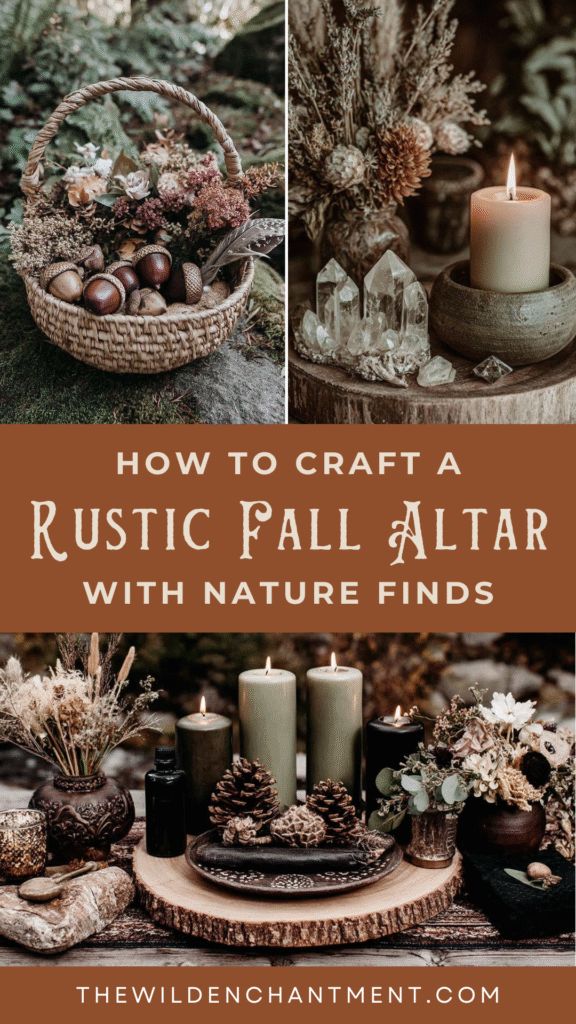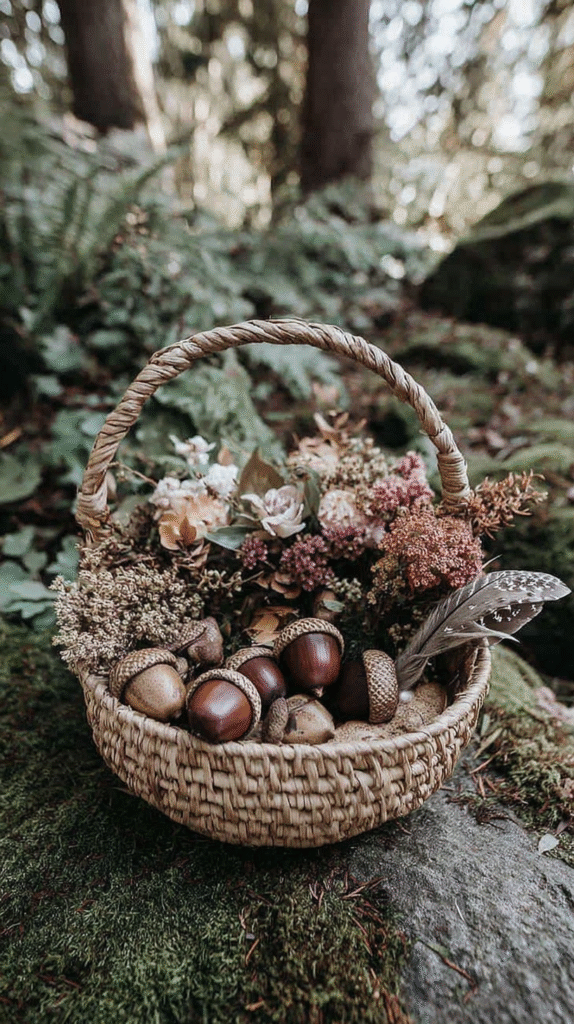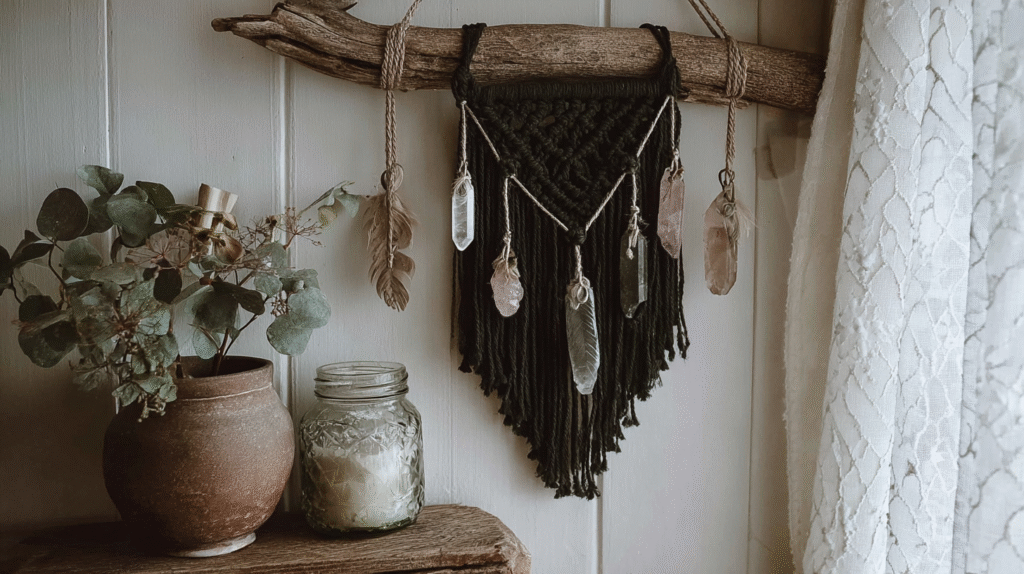This post may contain affiliate links, including those from Amazon Associates. If you make a purchase through these links, I may earn a commission at no additional cost to you. Learn more about our affiliate policy.
There’s a certain enchantment to autumn. The days shorten, the air cools, and nature puts on its most dramatic show, leaves flaming into gold and crimson before drifting to the ground.
This season invites us to pause and honor transitions, to celebrate abundance, and to gently let go of what no longer serves.
One of the simplest and most soulful ways to embody these rhythms is by creating a rustic fall altar.
An altar, at its heart, it is simply a dedicated space for reflection and intention, a corner where you can honor the season and connect with your inner world.
Using foraged finds from nature, you can craft something that feels grounded, sustainable, and deeply personal, an altar that reflects both the earth’s cycles and your own.

What Makes a Fall Altar Feel Rustic and Rooted
A rustic altar celebrates natural imperfection. It is built from simple materials: a wooden plank, a stack of stones, a thrifted tray, or even a patch of earth on your balcony.
The beauty lies in raw textures, organic shapes, and the layering of what you find rather than what you purchase.
Think earthy tones and tactile surfaces like bark, twine, dried grasses, rough stones, smooth pinecones, crisp leaves.
Add muted autumnal shades: rust, ochre, moss green, deep burgundy.
Rustic is about honoring authenticity, keeping things close to their natural state, and letting beauty emerge through texture and presence.
Gathering Foraged Materials Responsibly

The magic of a rustic fall altar begins outdoors. Step outside with a woven basket or canvas bag and notice what nature is offering.
Fallen leaves in brilliant hues, acorns scattered under trees, pinecones dropped onto mossy ground, feathers caught in branches, all can become sacred objects.
When foraging, follow a few mindful principles. Take only what is already fallen or abundant. Leave enough for wildlife and the land itself. Be respectful of private property and natural spaces, and check local guidelines about collecting.
Before bringing items inside, shake them free of insects and brush off dirt. You want your altar to feel alive with earth’s textures, but also clean and safe for your space.
If you enjoy weaving seasonal rhythms into your everyday life, you may also find inspiration in these fall self-care rituals to stay cozy and grounded.
Choosing Your Altar Base
An altar doesn’t have to take up much room. It can be a small tabletop, a windowsill, a low shelf, or even a wooden crate turned on its side. If you have an outdoor space, a tree stump, garden table, or balcony corner can serve beautifully.
Protect the surface with a natural cloth, a square of burlap, or even a slice of bark.
This grounding layer adds both texture and practicality, protecting your furniture while giving your altar a sense of being intentionally set apart.
Use a heavier object like a stone, sturdy branch, or small bowl to act as an anchor, giving weight to your arrangement and tying the elements together.
Elements to Include and Their Meanings

Every object you place can carry symbolism, making your altar not only beautiful but meaningful.
Candles are a natural centerpiece, offering warmth, light, and transformation.
Choose colors like orange, gold, brown, or cream. Scented candles with autumn notes like cedar, apple spice or cinnamon bring another sensory layer.
Crystals and stones can deepen the energy. Carnelian, amber, and smoky quartz resonate with fall’s grounding and fiery tones. Even simple pebbles or river stones hold presence and stability.
Offerings remind you of gratitude. Seasonal fruits, nuts, or dried herbs can be placed in small bowls as gifts back to the earth. Dried flowers like marigolds, chrysanthemums, or lavender add softness and color.
Symbols of letting go are powerful in autumn. Fallen leaves, feathers, or objects you’re ready to release can act as reminders of what you’re shedding. This transforms the altar into not only a place of beauty but also of personal transition.
Finally, include something personal. A photo, a keepsake, or an item that connects you to your ancestry or inner story weaves your altar into the fabric of your life.
Designing the Layout and Composition
When arranging your altar, trust your intuition. Rustic style thrives on asymmetry and layering.
Begin with taller elements like branches, dried grasses, or taper candles. Then add mid-level items like jars, bowls, or clusters of pinecones.
Then place smaller stones, crystals, or acorns at the base. This creates depth and dimension, drawing the eye in.
Play with contrast. Smooth surfaces alongside rough bark, vibrant leaves against muted moss, candlelight glowing on weathered wood.
Rustic beauty is found in these juxtapositions. Let the altar evolve as you add new finds from nature walks or as the season shifts.
Caring for Your Altar Over the Season
A rustic fall altar is not static. The items will shift, dry, and fade just as the season does.
Part of the beauty is tending it as you would a small garden. Refresh leaves or flowers when they crumble.
Replace fruit before it spoils. Dust and rearrange when it feels stagnant.
Cleansing is part of this care too. Light incense or herbs like sage, cedar, or rosemary to refresh the energy. Ring a bell or play gentle music near your altar. Place objects in moonlight overnight for renewal. This simple attention keeps your altar alive and attuned to you.
Practices to Use With Your Altar
The altar becomes most meaningful when you use it as more than decoration. Set aside moments each day or week to pause before it. In the morning, light a candle and state one thing you are grateful for. In the evening, write in your journal beside it, letting the altar’s presence hold your reflections.
Meditation is another way to connect. Sit quietly in front of your altar, focusing on your breath, the flicker of candlelight, or the textures of the natural items. Notice what feelings arise.
You can also use your altar for seasonal rituals. During harvest time, leave a small bowl of food as an offering of gratitude.
Around Samhain, light candles to honor ancestors. As the season deepens, write down what you wish to release and place it beneath a fallen leaf on your altar. These small acts create a rhythm of honoring both the outer season and your inner landscape.
Creating an altar pairs beautifully with other grounding habits, such as a morning routine aligned with nature’s rhythm.
Safety and Practical Tips
If you include candles, always keep them in safe holders and never leave them unattended.
Place them away from dried leaves, grasses, or fabrics that could catch fire. Choose materials that dry well, like pinecones, bark, or seed pods, and avoid bringing in anything that might rot quickly.
When foraging, avoid plants that are toxic or unfamiliar. A little research goes a long way toward ensuring safety.
Closing Thoughts
A rustic fall altar is not about perfection. It is about connection—connection to nature, to the cycles of change, and to your own intuition. Each branch, stone, or leaf carries a fragment of the season’s story, and when you gather them together, you create a mirror for your own inner shifts.
The act of crafting an altar with foraged finds slows you down, drawing you into relationship with your environment. Each time you pass it, you are reminded to breathe, to notice, and to honor the fleeting beauty of autumn.
You do not need much. A few found objects, a candle, a small surface. What matters is the intention you bring. This season, let your altar be a sanctuary—simple, soulful, and rustic—where you can rest in gratitude and gather strength for the months to come.



